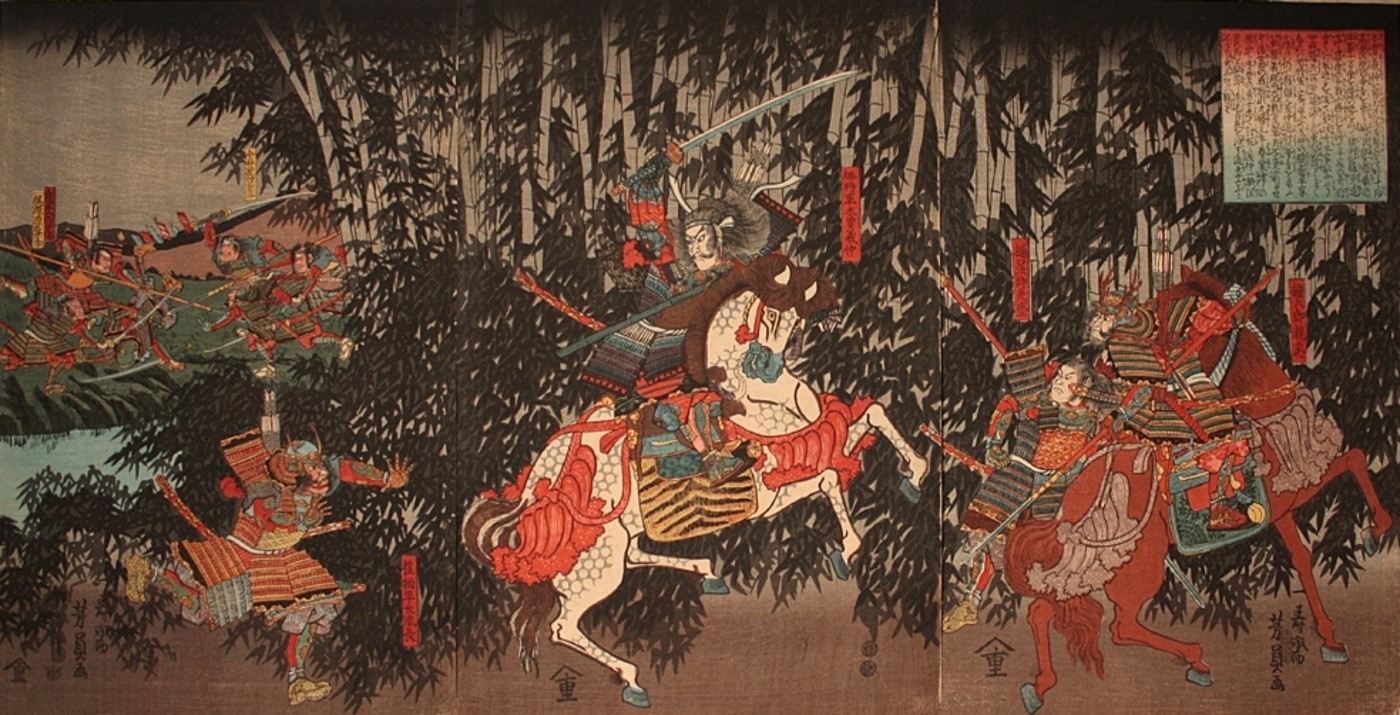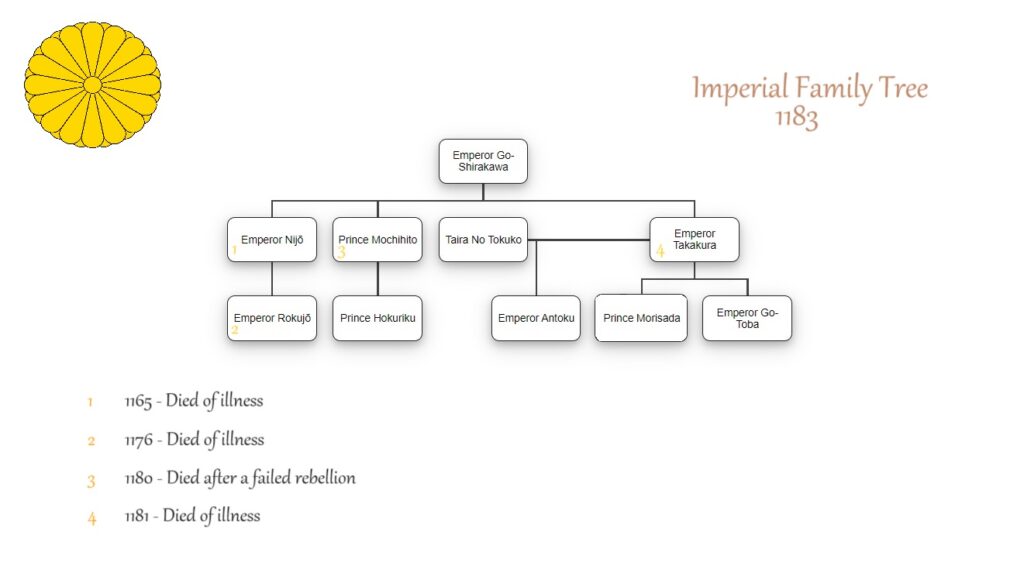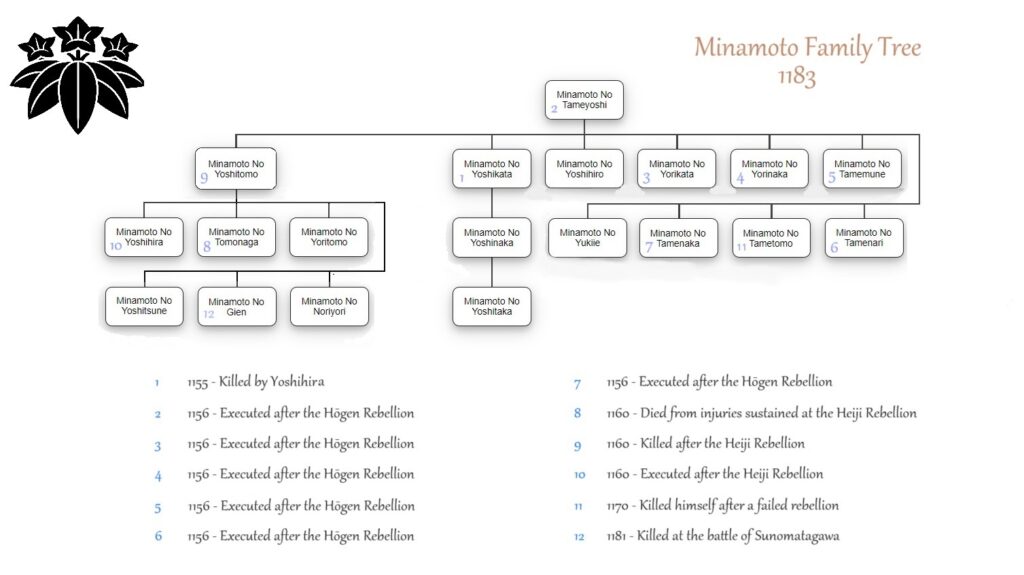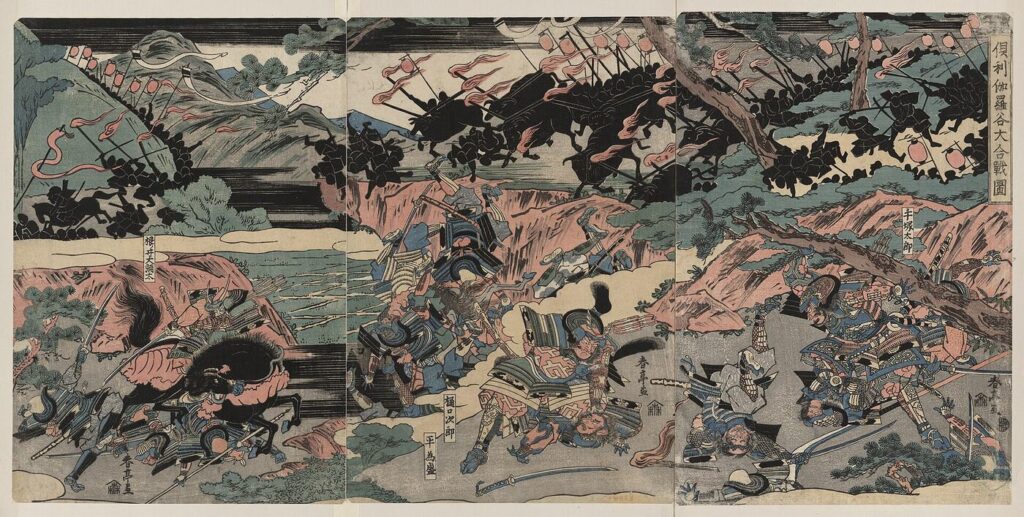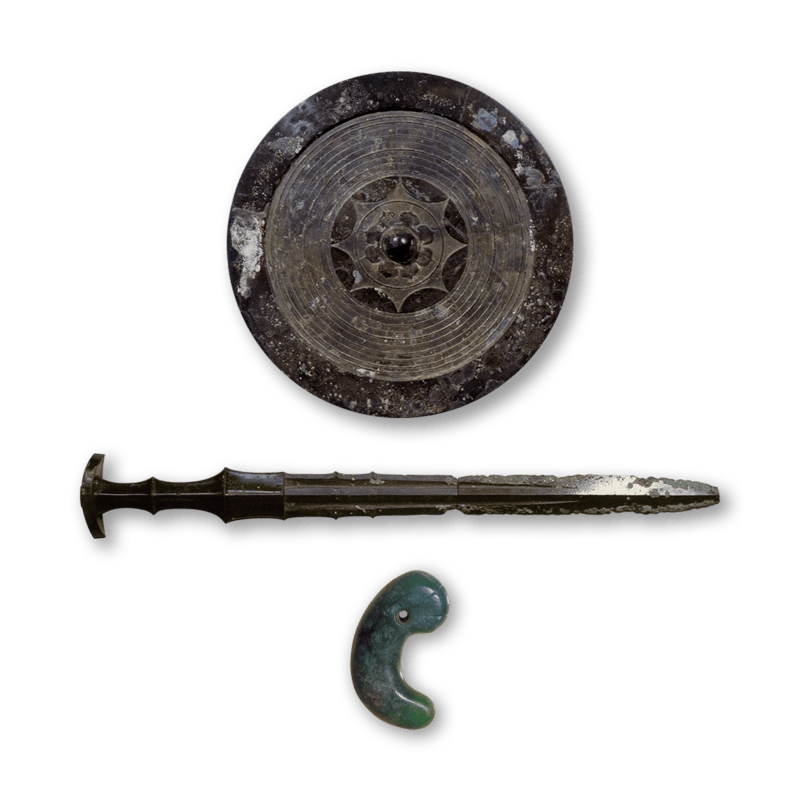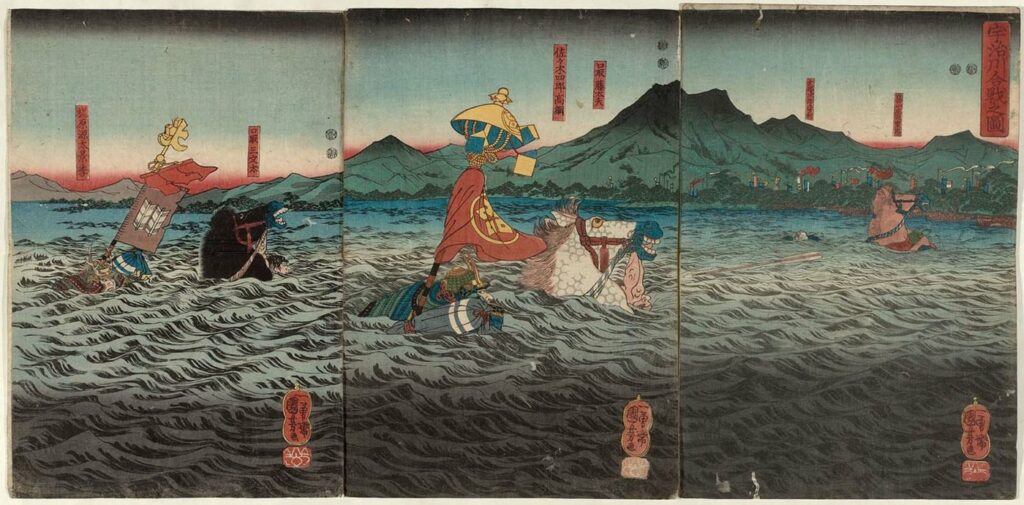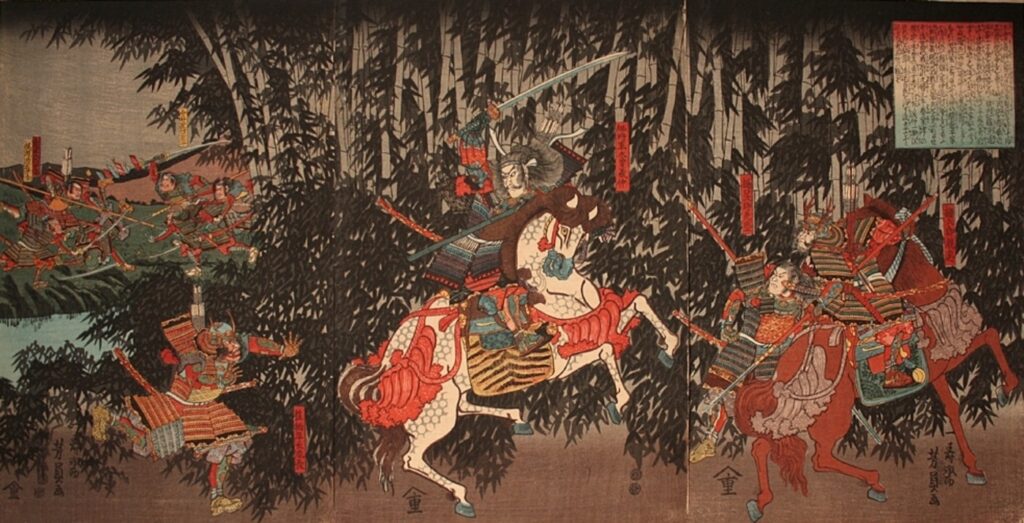The Genpei War Pt. 3
We’re on to part three of the 5-year long epic Genpei War now. Things are really starting to heat up. Yoritomo settled himself into Kamakura and is busy taking over the east, leaving the Takeda and his uncle to take care of the front line and put a stop to any Taira advances. Things are about to get even more fiery though; the long drought that caused the death of thousands in the capital is finally over, and the Taira are looking to advance into Hokuriku with an army of over 100,000!
As you’ll soon discover, however, subduing Hokuriku won’t be as easy as the Taira expect; Kiso Yoshinaka had already sneaked his way into the Genpei War, and he’d been very busy during the Taira’s 18-month hiatus. By May of 1183, he’d managed to convince most of Hokuriku to switch to his side, and he didn’t plan on handing over even a scrap of land from his newfound empire. As a bonus, he’d even managed to pick up Prince Mochihito’s son, who had been hiding out in Hokuriku. Having a member of the Imperial Family on his side gave him a way into the capital, but he still had to do something about the massive Taira army at his doorstep.
As always, if you haven’t read parts one or two, go back and do so, or you’ll have little idea what’s going on. For everyone else, refer to the map of feudal Japan and the family trees whenever you need to. (Click on individual images to open them).
Breaking into Hokuriku(again)
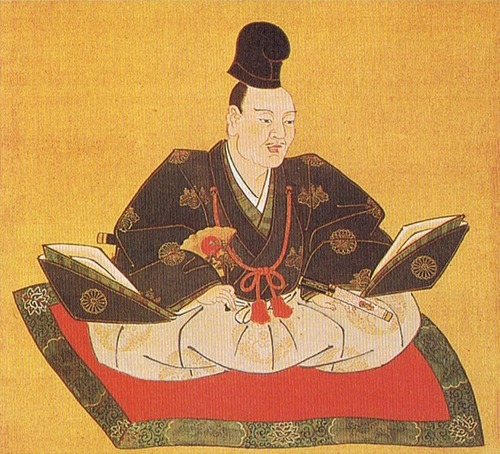
Taira no Koremori led his vast army out of the capital and marched them north. He reclaimed Echizen with ease and forced Yoshinaka’s troops back to Ecchū. After dividing his army into two separate troops, he led 70,000 men up Mt. Tonami, a 1800 ft high mountain, and set up camp. Yoshinaka led his army to the foot of the mountain and stared out Koremori. His army was significantly smaller than the Taira force. Various resources give different reports as to the actual size, but even the most optimistic report quotes him as having less than half the number of men that Koremori had at his disposal. As a side point, among his newly-formed army was his uncle, Yukiie, who had been more or less banished from Kamakura and the Genpei War after his humiliating defeat at Sunomatagawa.
The Battle of Kurikaratōge
Despite this vast difference in manpower, Yoshinaka made the first move, ordering his men to open fire. Arrows flew high but fell short of their target. That wasn’t important though; the arrows were simply a decoy. While Koremori’s eyes were focussed on Yoshinaka, Higuchi Kanemitsu, one of Yoshinaka’s most loyal followers, secretly led a small team to the back of the mountain and positioned them directly below the Taira army. When night fell, Yoshinaka blew a horn to initiate the battle and charged his men up the mountain. Legend has it he attached torches to the horns of several hundred bulls and had them lead the attack. Epic as this would have been, unfortunately, the tale is only documented in the least verifiable resource we have for the Genpei War.
Bulls or no bulls, the attack was brutal. The Taira army, who were still half asleep, jumped to their feet, startled, grappling for weapons. Many decided to flee, but their attempts were thwarted by Kanemitsu, who had led his men quietly up the back of the mountain to cut off the Taira’s escape route. Only one path remained for the panicked masses: Kurikaratōge—a sharp mountain ridge atop a sheer 1000 ft high cliff. Thousands ran off the edge without even knowing where they were or what they were doing. Some saw the ridge and tried to warn the others, but their voices couldn’t be heard over the screams of terror. Their stampeding comrades trampled them and dragged their beaten bodies over the edge. It was chaotic. One perfectly-executed sneak attack had caused the fall of the Taira’s 70,000-strong army.
| Taira | Minamoto | Kiso |
|---|---|---|
| 3 | 1 | 1 |
A Powerful Alliance
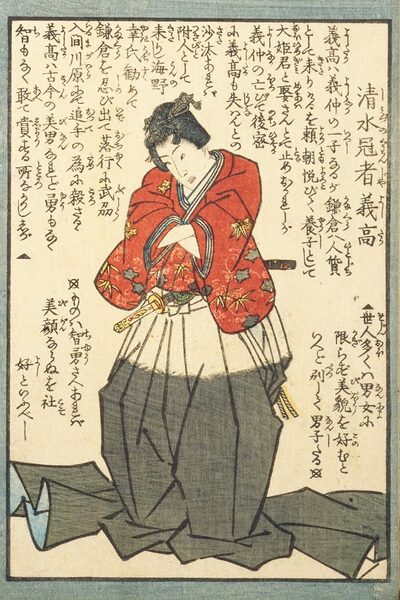
A dumbfounded Koremori led the handful of men he had left back to Kaga, abandoning Ecchū. Yoshinaka, his momentum maxed out, tracked down the rest of the Taira army and drove them out of Hokuriku, effectively eliminating the Taira threat and clearing the path to the capital.
There were still some loose ends to tie up before he set off, however. Several months before Kurikaratōge, Takeda Nobuyoshi’s son, Nobumitsu, asked Yoshinaka’s permission to marry his daughter to Yoshinaka’s 10-year-old son, Yoshitaka. Yoshinaka refused. An infuriated Nobumitsu ran to Yoritomo and spread a rumour that Yoshinaka was planning to take down Kamakura. This left Yoshinaka with no choice but to form an alliance with Yoritomo by marrying his son to Yoritomo’s daughter. (Fate must have really wanted Yoshitaka married! At least Yoritomo made for a stronger ally though.) Yoshinaka sent his young son to Kamakura to seal the deal.
The Taira’s flight
Meanwhile, the Taira, having depleted the bulk of their troops, decided to abandon the capital and flee west in a bid to rebuild their army with soldiers from the few areas of land they still had under their control. Joining them on this venture were Emperor Antoku and his younger brother, Prince Morisada(who was next in line for the throne), and the three sacred treasures of Japan: the Sword of Kusanagi, the Yata Mirror and the Yasakani Bead.
These treasures had been in the possession of the Imperial Family since before documented history. They were required for the ascension ceremony of a new emperor. By taking the current emperor and the three treasures with them, the Taira ensured that the court couldn’t crown a new emperor in their absence. This provided them with a powerful bargaining chip. They had intended to take Retired Emperor Go-Shirakawa with them too, but he got wind of their plan and escaped to Enryakuji before they could find him.
Yoshinaka Enters the Capital
In July of 1183, Yoshinaka became the first contender of the Genpei War to reach the capital. Since the Taira’s evacuation, there had been no one policing the capital. For that reason, Yoshinaka’s arrival relieved the court. However, few of Yoshinaka’s men(himself included) had ever set foot in the capital. Compared to the refined and cultured nobles who made up the court, their clothes were shabby, their speech crude and their manners atrocious. Go-Shirakawa wasn’t sure how to go about forming a lasting relationship with these barbarians. Nevertheless, he awarded Yoshinaka and Yukiie titles(as a formality), and recognised their right to the land they had taken from the Taira in Hokuriku and Shinano.
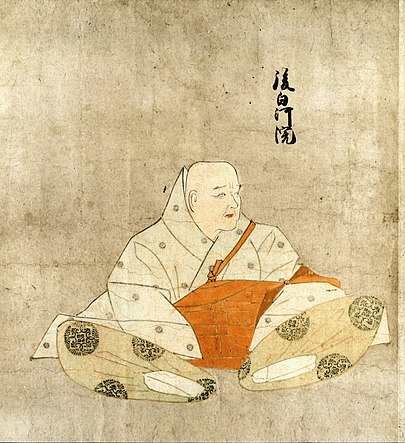
The two sides maintained a more or less stable relationship. That is until it came time to discuss the main issue that had been plaguing the court since the Taira fled the capital: the fact that there was no emperor on the throne. The court was in favour of naming one of Emperor Antoku’s two remaining brothers the new emperor. If it came to it, they were even willing to have him ascend the throne without the three treasures.
Naturally, Yoshinaka supported Prince Mochihito’s son. He argued that had it not been for the interference of Taira no Kiyomori, Prince Mochihito would have been made emperor. As such, his son was the rightful heir to the throne. It was a decent argument, but it wasn’t enough to convince the court. At the end of the day, whether or not Mochihito should have been emperor was irrelevant. The fact remained that he hadn’t become the emperor, and, therefore, his son’s ties to the imperial line were weaker than those of the other candidates.
Tension was forming between Yoshinaka and Go-Shirakawa. To make matters worse, Yoshinaka had little control over his men, who began demanding food from and, in worse cases, stealing from local farmers. Far from protecting the capital, since arriving, Yoshinaka had actually made the crime situation worse! Go-Shirakawa had reached the end of his tether. He ordered Yoshinaka to chase down the Taira and regain the emperor and treasures, the implication being that should he fail, he’d be banished from the capital for good.
The Battle of Mizushima
In October, Yoshinaka led 7,000 men and 500 ships to the island of Mizushima—the Taira’s new front line. Word having reached the Taira in advance, they prepared for their enemy’s arrival, tying their fleet of 1,000 or so ships tightly together and laying planks between them to form a giant makeshift platform by the shore, atop which they could conduct the impending battle. When Yoshinaka’s army arrived, the Taira opened fire with a barrage of arrows, inviting their unwitting prey onto the platform. Steel clashed with steel until the Taira deliberately fell back, leading their steeds into the water and wading their way back to the shore, luring the enemy onto dry land. The battle was long and fierce, but the Taira emerged victorious.
As a side note, there’s mention in a certain source that during the battle, an annular eclipse occurred, blocking 95% of the sun. This apparently caused panic among Yoshinaka’s forces, whereas the Taira, who had knowledge of astronomy from the advanced education they had received in the capital, were able to remain calm. This is cited as one reason for the Taira’s victory. However, this is the same source that claims Yoshinaka marched an army of flaming bulls up a mountain. If one of these stories is to be believed, the other is too. I’ll leave that judgment to you!
| Taira | Minamoto | Kiso |
|---|---|---|
| 4 | 1 | 1 |
The Battle of Hōjūji
Meanwhile, back in the capital, no sooner had Yoshinaka left to face the Taira than Go-Shirakawa sent a messenger to Kamakura pleading for Yoritomo’s help. The two went back and forth negotiating until Yoritomo agreed to send his men west in return for Go-Shirakawa’s acknowledgment of the return of all land in the east previously occupied by the Taira. This included not only land which the Taira had stolen from his followers, but also land which had originally belonged to shrines, temples and nobles. As this condition was also of benefit to himself and his entourage, the retired emperor was more than happy to oblige.
In addition to the return of all land formerly under Taira control, he also acknowledged Yoritomo’s right to the Kantō plain. However, out of fear of Yoshinaka’s retaliation, he refused to hand over the rights to Hokuriku or Shinano, and he insisted that Yoritomo attempt to negotiate a peace treaty with Yoshinaka.
The deal having been sealed, Yoritomo tagged his brother, Yoshitsune, into the Genpei War with an army of over 30,000. As soon as Yoshinaka got wind of this development, he rushed back to confront Go-Shirakawa. When Go-Shirakawa got wind of this development, he had Enrayakuji and Onjōji send as many men as they could spare and set to work fortifying his home temple, Hōjūji, constructing fences and digging a moat around the exterior of the complex.
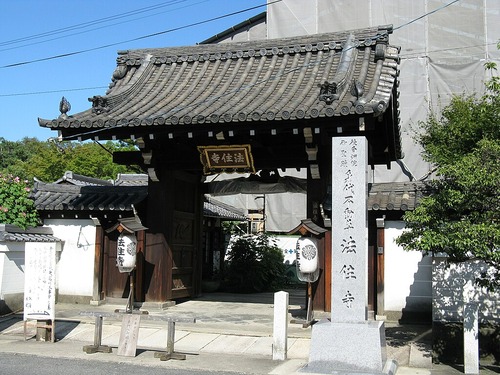
By the time Yoshinaka made it back to the capital, the retired emperor was safely tucked away inside his ‘castle’. Rather than meet with his aggressor and discuss the situation civilly, he had his men order Yoshinaka to go hunt down the Taira again, this time with the condition that if he started a war against Yoritomo or if he refused to leave the capital and fulfill his duty, the court would consider him a traitor. Despite the severity of the consequences, Yoshinaka refused. Go-Shirakawa’s makeshift defences and hastily-gathered army were no match for the might of his indignant soldiers. It was a bloodbath; they slaughtered as many men as it took to gain access to the temple and kidnap the retired emperor. From that day on, Yoshinaka controlled the court. He immediately fired 43 of Go-Shirakawa’s most loyal officials and replaced them with men he could trust.
| Taira | Minamoto | Kiso |
|---|---|---|
| 4 | 1 | 2 |
The Battle of Ujigawa
In January of 1184, Yoshinaka forced the court to authorise an attack on Kamakura. Yoritomo responded by sending another of his brothers, Noriyori, with a second set of troops to join Yoshitsune, who was on standby in Ōmi. While Yoritomo’s army was growing, Yoshinaka’s was dwindling; the defeat he faced at Mizushima had dealt a major blow to his soldiers’ morale. They began to desert in flocks. The 30,000-plus force Yoshinaka had marched to the capital was down to just short of a thousand men.
He sent 500 of his remaining men towards Ōmi, 300 to Uji(where, if you’ll remember, the Genpei War began), and kept his 100 or so remaining men in the capital to protect him. Noriyori marched 30,000 men to intercept the troops in Ōmi while Yoshitsune led 25,000 to Uji. (The numbers pretty much say it all. Shall we skip the details and go straight to the outcome?)
Yoshinaka’s phenomenally outnumbered men fired a barrage of arrows across the river to Yoshitsune’s invading army, who rode their horses straight into the water and struggled their way across—which, if you’ll remember back to Prince Mochihito’s rebellion, was no easy task. Once across, they swarmed Yoshinaka’s troops, forcing them to flee and freeing up the road to the capital.
| Taira | Minamoto | Kiso |
|---|---|---|
| 4 | 2 | 2 |
The Battle of Awazu
Fired up from the easy victory, Yoshitsune charged his battle-hungry men into the capital to confront Yoshinaka. Having just 100 men to protect him, Yoshinaka had no choice but to jump on his horse and leave to meet up with his friend and most loyal soldier, Imai Kanehira, whom he had put in charge of the Ōmi attack. By the time they rendezvoused, they were down to just a handful of men each. That number decreased further as the enemy advanced.
As they approached Awazu in the south of Ōmi, the two realised there was no hope. They agreed to search for a secluded forest area where they could kill themselves before the enemy had a chance to take them. On their way, however, Yoshinaka’s horse became stuck in a deep marsh field. As he tried to free himself, an arrow struck him in the head, killing him and ending his part in the Genpei War. Kanehira escaped and followed through with the plan, ending his life and joining his friend.
Several months later, Yoritomo ordered the death of Yoshinaka’s son, whom he was still holding hostage in Kamakura under the pretense of being married to Yoritomo’s daughter. Despite the fact their marriage was arranged and despite them both still being children, Yoritomo’s daughter had developed strong feelings for Yoshitaka in the short time they had been together. Unable to cope with his execution, she helped him escape Kamakura. Yoritomo quickly discovered their plan, however, and sent his men after the boy. They found Yoshitaka in a matter of days and killed him on the spot. This marked the end of Kiso Yoshinaka’s bloodline.
| Taira | Minamoto | Kiso |
|---|---|---|
| 4 | 3 | X |
On that tragic note, we are now down to two horses. Taira vs Minamoto. Who’s your money on? Join me in part four where we’ll cover the final saga of the epic Genpei War.


